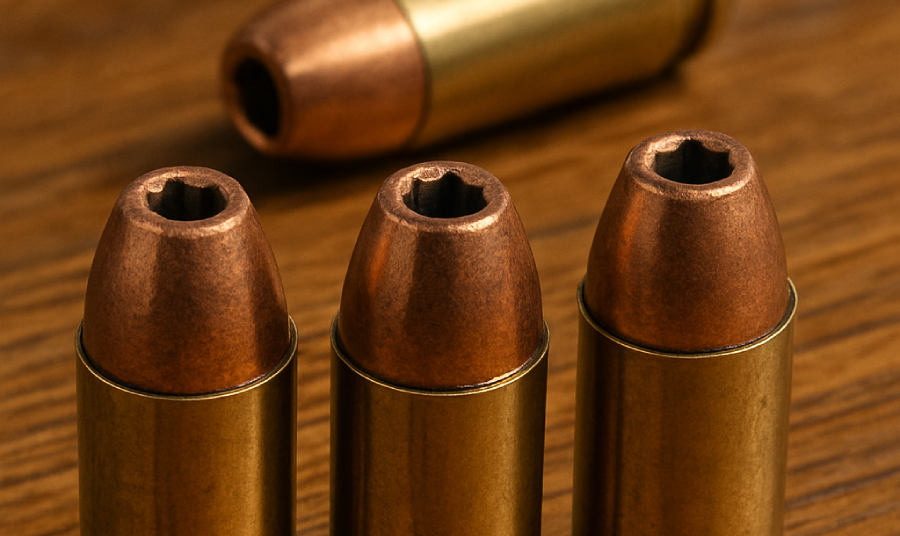Hollow point ammunition has been around for a long time, evolving from early designs in the late 19th century when shooters realized that a bullet that expanded on impact could do more damage to a target. The British Empire famously used Dum-Dum bullets—named after the arsenal in India where they were developed—which featured exposed lead tips designed to mushroom upon impact. These rounds were so effective at causing catastrophic wounds that they were banned for use in warfare under the Hague Conventions of 1899.
But while hollow points are never used for warfare, they’re the go-to for law enforcement and self-defense, because they do exactly what they were designed to do—stop threats quickly and effectively.
The Purpose of Hollow Points
Hollow point bullets are engineered with a cavity at the tip that causes them to expand upon impact. This expansion does two things:
-
Maximizes Stopping Power – Unlike full metal jacket (FMJ) rounds, which can punch straight through a target, hollow points dump all their energy into the target, causing greater tissue damage and reducing the risk of overpenetration. This makes them an excellent choice for defensive situations where you don’t want a bullet passing through an attacker and hitting an innocent bystander.
-
Better Terminal Performance – The expansion of the round increases its diameter, making it more effective at incapacitating threats. In law enforcement, this is critical because officers need to neutralize a threat as quickly as possible. In self-defense, it means fewer shots may be needed to stop an assailant.
-
Safer for Urban Environments – Since hollow points are less likely to overpenetrate compared to FMJs, they are a better option in crowded areas where missed shots could put bystanders at risk.
It’s no wonder police departments, concealed carriers, and even some security personnel rely on hollow points. They hit hard and stop threats fast. But there’s one thing they don’t do—penetrate body armor.
Hollow Points vs. Body Armor
Despite what Hollywood might show, hollow points are completely ineffective against modern body armor. That’s because body armor—especially soft armor rated at Level II or IIIA—is designed to absorb and distribute the force of a bullet, preventing penetration.
Hollow points, by design, expand when they hit a target. That’s great for stopping an unarmored attacker, but it works against them when hitting armor. Instead of punching through, the bullet mushrooms out even more dramatically, dumping its energy into the armor itself and failing to penetrate. That means if someone wearing soft body armor takes a hit from a 9mm or .45 ACP hollow point, they’ll feel the impact, but the round isn’t getting through.
So, if you’re worried about bad guys using hollow points, you should know that a BulletSafe VP4 vest (or any Level IIIA-rated soft armor) will stop them cold. But that brings us to a critical warning—what will penetrate body armor?

Rifle Rounds: A Different Beast
Soft armor is not designed to stop rifle rounds. Even though pistol-caliber hollow points won’t get through, common centerfire rifle cartridges like .223 Remington (5.56 NATO) and 7.62x39mm will cut through Level IIIA armor like a hot knife through butter. Why?
-
Velocity – Rifle rounds travel much faster than handgun rounds, with speeds often exceeding 2,500 feet per second. That’s far beyond what soft armor is designed to handle.
-
Pointed Shape and Construction – Unlike hollow points, most rifle bullets have a streamlined, full metal jacket (FMJ) or armor-piercing (AP) design that helps them maintain structural integrity on impact. Instead of flattening out, they pierce straight through.
If you want protection against rifle threats, you need hard armor plates rated at Level III or IV. These are the only options capable of stopping high-velocity rifle rounds, with Level IV plates being able to defeat armor-piercing rounds.
Hollow points are the best choice for self-defense, home defense, and law enforcement when dealing with unarmored threats. They deliver maximum stopping power while reducing the risk of overpenetration. But if you’re relying on them to defeat body armor, think again—they simply don’t have what it takes.
If armor penetration is the concern, rifle rounds are a whole different animal, and only Level III or IV plates can offer the protection you need.
So, if you’re running a BulletSafe VP4 vest with Level IIIA protection, you’re covered against handguns and even shotgun slugs. But if rifle rounds are a threat in your environment, upgrade to rifle-rated plates.
Know your ammo. Know your armor. Stay protected.
To shop BulletSafe bulletproof vests, click here.
Frequently Asked Questions
1. What is the purpose of hollow point bullets?
Hollow point bullets are designed to expand upon impact, maximizing stopping power and increasing terminal performance.
2. Are hollow points safer for urban environments?
Yes, hollow points are less likely to overpenetrate compared to FMJ rounds, making them a better option in crowded areas.
3. Can hollow points penetrate body armor?
No, hollow points are ineffective against modern body armor as they expand upon impact, preventing penetration.
4. What type of ammunition can penetrate body armor?
Rifle rounds are capable of penetrating body armor, unlike hollow points which are designed to expand upon impact.
5. Why are hollow points preferred for law enforcement and self-defense?
Hollow points are preferred for their ability to quickly and effectively stop threats without risking overpenetration.

